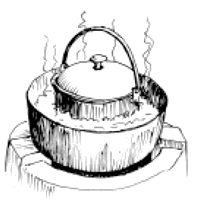The preparation of a medicine from a plant that contains a beneficial chemical varies according to the chemical and the plant. Sometimes the chemical is extracted from the leaves by the use of boiling water. Sometimes the roots are dug up and ground. The most basic and common process for producing medicines is to use liquid and heat.
Here is a list of some of the varied processes that can be used. Pages 8 and 9 then contain examples of how these processes are used to produce medicines from just seven common plants. There are, of course, hundreds of beneficial plants that can be used. We have just selected a few which are widely known and have been tested, tried and researched scientifically.
Cold water extracts
This is used for ingredients that are destroyed by heat. Leaves should be cut into small pieces. Roots should be pounded. Soak ingredients overnight in cold water. Use within one day.
Tea (or brew)
Pour one litre of boiling water over a handful of herbs. Leave to stand and after 15–20 minutes filter through a clean cloth. Use within one day.











